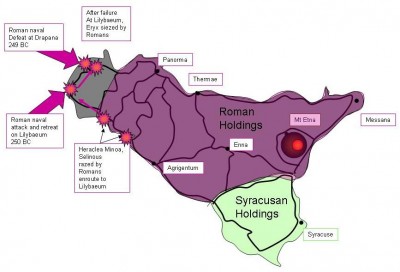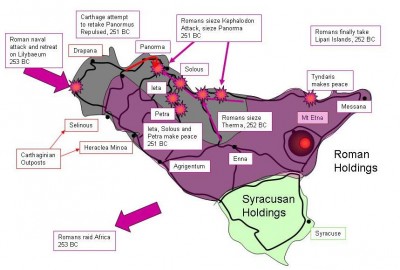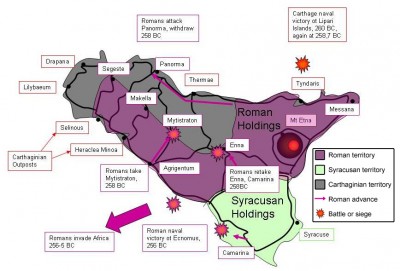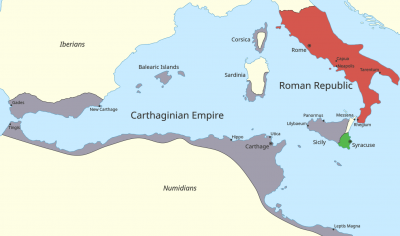Carthaginian commander Hanno the Elder (???-????? BC)
We do not know much about Hanno the Elder, as we do not know much about a significant number of Carthaginian commanders involved in the First Punic War. He was the son of Hannibal Gisco and enters the scene of the First Punic War at its very beginning (in the summer of 264 BC). Either he was in Sicily when the war began and took command of the army sent from Africa at Acregauntum (a Carthaginian allied city) after the Romans had expelled the Carthaginian garrison from Messana and taken the city themselves, or he arrived in Sicily with that army. In any case, he made an alliance with the traditional Carthaginian enemy (and Roman ally) Hieron of Syracuse and marched with the Syracusans to Messana to retake it. When he refused the Roman ultimatum, the Roman consul Appius Claudius Caudex declared war on Carthage - thus officially beginning the First Punic War.
Hanno was driven out of Messana by the Romans in the autumn of 264 BC, as was his ally Hiero. In the first half of 263 BC, he was forced to retreat as far as Acreganto, while Hiero presciently switched to the Roman side - although Syracusan ground forces were not directly involved in the war with Carthage. Hanno therefore left Acreganto, which had now become a Carthaginian stronghold, and presumably went to Africa for reinforcements. The garrison left behind in Acreganto was meanwhile commanded by his father Hannibal Gisco. Before the new troops were assembled and sent to Sicily, however, the Romans, in the summer of 262 BC. Akreganto was besieged. Hannibal resisted the attack, and Hanno hastily sailed his (according to various sources) 30,000-60,000 men to the southern coast of Sicily and went to the aid of the besieged city.
In several skirmishes of cavalry (the Romans traditionally built the strength of their army on the foot soldier), he managed to gain a strategic advantage, capturing a Roman supply camp and building his own camp near the city. This cut off the Roman supply routes and put the Romans in a similar position to the besieged Acreganto. After six months, the Roman commanders (both consuls for this year) saw no other option but to confront the Carthaginians in a regular battle (in late 262 and early 261 BC). Hanno the Elder, however, could not coordinate the battle sufficiently with his father in Acreghant despite the Roman siege ring.
Different accounts of the Battle of Acreghant contradict each other. A part of the Roman army under the command of L. Postumius Megallus apparently marched against Hannon the Elder, while the other part had to prevent the besieged from making a sortie out of the city ([i:aaaa]which they did for the moment). Some sources mention that the Romans drove off Hannon's elephants at the beginning of the battle, which then wreaked havoc in their own ranks. This could also explain the fact that although the Romans won the battle, Carthaginian losses were most likely relatively low. In any case, the Romans prevailed and the Carthaginians lost their appetite to fight them in regular battles. Hanno's forces withdrew to the West Sicilian fortresses, Hanno himself leaving Sicily and returning to Carthage in January 261 BC.
He was punished for his failure in battle with a heavy fine of 6,000 talents of gold, but he could speak of his good fortune in not being crucified, as happened to other unsuccessful Carthaginian commanders ([i:aaaa]including his father a few years later). Moreover, he regained the confidence of the Carthaginian leadership and by 258 BC he was again involved in the fighting in Sardinia, where the Romans had meanwhile tried to transfer the fighting (which they did, but did not achieve a decisive victory there either). So in 256 BC, the Roman fleet went to the African shores to land the Roman army there and decide the war directly in the Carthaginian homeland. On the way, in a gigantic naval battle at Cape Ecnomus, it clashed with the Carthaginian fleet (more than 300 ships on each side), which was commanded by Hanno together with Hamilcar. This time the Carthaginians were not victorious either, but rather defeated, losing 80 ships (30 were sunk by the Romans, 50 captured). Neither Hanno nor Hamilcar were blamed for this failure.
Hanno may have been sent to negotiate peace with the Romans, but they imposed such harsh conditions that the Carthaginians were unwilling to accept them. In the meantime, they landed in Africa and achieved several successes, and Hanno was called back to become one of the senior commanders of the Carthaginian army in Africa (which eventually actually defeated the Romans at the last possible moment). Hannon's mark on history disappears for us at this point.
Sources:
Polybios (online version e.g. penelope.uchicago.edu )
www.kleio.cz
www.roman-empire.net
http://www.barca.fsnet.co.uk/
Římské útoky 250-249 př. n. l.
Lazenby, John Francis (1996). The First Punic War: A Military History. Stanford, California: Stanford University Press. ISBN 0-8047-2673-6., CC BY-SA 3.0, commons.wikimedia.org
Římské útoky 253-251 př. n. l.
Lazenby, John Francis (1996). The First Punic War: A Military History. Stanford, California: Stanford University Press. ISBN 0-8047-2673-6., CC BY-SA 3.0, commons.wikimedia.org
Pokračující římský postup 260-256 př. n. l.
Lazenby, John Francis (1996). The First Punic War: A Military History. Stanford, California: Stanford University Press. ISBN 0-8047-2673-6., CC BY-SA 3.0, commons.wikimedia.org
Mapa západního Středomoří v roce 264 př. n. l. se zaměřením na země zapojené do první punské války.
commons.wikimedia.org



